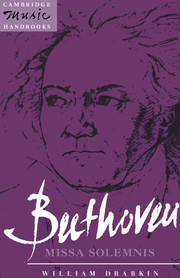2 - Composition, performance and publication history
Published online by Cambridge University Press: 05 June 2012
Summary
Background
Beethoven began to compose the Mass in D in the spring of 1819, on learning that Rudolph, Archduke of Austria, was to be made Archbishop of Olmütz in Moravia (now Olomouc, Czechoslovakia).
Rudolph (1788–1831), the youngest brother of Emperor Franz II, had been one of the three signatories to the contract of 1809 which guaranteed Beethoven a substantial annuity in return for remaining in Vienna. It was around this time that Rudolph became a pupil of Beethoven, receiving regular lessons in piano and composition for the next fifteen years. He proved to be the most generous and reliable of the composer's patrons during his last two decades; in return, Beethoven dedicated a large number of major works to him, including the fourth and fifth piano concertos, three large piano sonatas, the Mass and the Große Fuge for string quartet. Of these, the Sonata in E♭ (‘Das Lebewohl’, or ‘Les adieux’) represents the most personal expression of Beethoven's affection, its three movements being built around the programme of Farewell, Absence and Return which depicts the composer's feelings towards his pupil during the latter's enforced removal from war-torn Vienna in 1809–10.
- Type
- Chapter
- Information
- Beethoven: Missa Solemnis , pp. 11 - 18Publisher: Cambridge University PressPrint publication year: 1991



